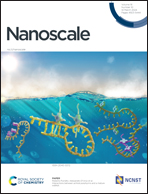Polyoxometalate nanocluster-infused triple IPN hydrogels for excellent microplastic removal from contaminated water: detection, photodegradation, and upcycling†
Abstract
Microplastic (MP) pollution pervades global ecosystems, originating from improper plastic disposal and fragmentation due to factors like hydrolysis and biodegradation. These minute particles, less than 5 mm in size, have become omnipresent, impacting terrestrial, freshwater, and marine environments worldwide. Their ubiquity poses severe threats to marine life by causing physical harm and potentially transferring toxins through the food chain. Addressing this environmental crisis necessitates a sustainable strategy. Our proposed solution involves a highly efficient copper substitute polyoxometalate (Cu-POM) nanocluster infused triple interpenetrating polymer network (IPN) hydrogel, comprising chitosan (CS), polyvinyl alcohol (PVA), and polyaniline (PANI) (referred to as pGel@IPN) for mitigating MP contamination from water. This 3D IPN architecture, incorporating nanoclusters, also enhances the hydrogel's photodegradation capabilities. Our scalable approach offers a sustainable strategy to combat MPs in water bodies, as demostrated by the adsorption behaviors on the hydrogel matrix under varying conditions, simulating real-world scenarios. Evaluations of physicochemical properties, mechanical strength, and thermal behavior underscore the hydrogel's robustness and stability. Detecting minute MP particles remains challenging, prompting us to label MPs with Nile red for fluorescence microscopic analysis of their concentration and adsorption on the hydrogel. The catalytic properties of POM within the hydrogel facilitate UV-induced MP degradation, highlighting a sustainable solution. Our detailed kinetics and isotherm studies revealed pseudo-first-order and Langmuir models as fitting descriptors for MP adsorption, exhibiting a high maximum adsorption capacity (Qm). Notably, pGel@IPN achieved ∼95% and ∼93% removal efficiencies for polyvinyl chloride (PVC) and polypropylene (PP) MPs at pH ∼ 6.5, respectively, also demonstrating reusability for up to 5 cycles. Post-end-of-life, the spent adsorbent was efficiently upcycled into carbon nanomaterials, effectively removing the heavy metal Cr(VI), exemplifying circular economy principles. Our prepared hydrogel emerges as a potent solution for MP removal from water, promising effective mitigation of the emerging pollutants of MPs while ensuring sustainable environmental practices.

- This article is part of the themed collections: Nanoscale 2024 Emerging Investigators, Nanoscale Most Popular 2024 Articles and Celebrating International Women’s day 2024: Women in Nanoscience


 Please wait while we load your content...
Please wait while we load your content...